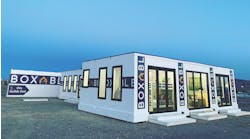Special to CONTRACTOR
WASHINGTON — The U.S. Environmental Protection Agency has announced a revised Version 1.1 of its WaterSense program specification for tank-type toilets. The revision came in response to some minor loopholes, certification issues, and because of changes in technology, notably the increased popularity of 3-in. flush valves.
WaterSense released its initial Tank-Type High-Efficiency Toilet Specification in January 2007. Since that time several issues requiring clarification came to EPA’s attention, including tanks with adjustable water use settings, certification and labeling of tanks and bowls manufactured and sold by different companies, and compliance with the aftermarket closure seal requirements now that 3-in. adjustable flappers are readily available on the market.
Consequently, EPA issued Version 1.1 of the specification, which incorporates these clarifications and provides some minor revisions necessary to align the specification with the other WaterSense product specifications. Version 1.1 becomes effective Nov. 1, 2011.
To read a summary of the changes, click here [opens as pdf].
While WaterSense is an EPA program, DOE is the agency with statutory authority over efficiency rules, so it gets to dictate program specifics.
DOE, through its February 2011 Energy Conservation Program: Certification, Compliance, and Enforcement for Consumer Products and Commercial and Industrial Equipment rulemaking, has clarified the application of its statistical sampling plans by which products are evaluated for compliance.
To be consistent with DOE’s sampling plan requirements, EPA is now requiring both single flush and dual flush toilets to be sampled and statistically evaluated in accordance with the Code of Federal Regulations (CFR) 10 CFR 429.30, the governing sampling plan for water closets. This change replaces the sampling plan requirements created by the ANSI/ASME A112 committee that concerns itself with toilets.
EPA pointed out that other WaterSense products were being tested with the applicable DOE sampling plans.
EPA has added a new section to the specification to address tank and bowl product-marking requirements.
First, tanks must be marked in accordance with ASME A112.19.5, which requires the manufacturer to permanently mark or label the tank with information pertaining to the appropriate flush valve replacement parts. When a flush valve seal or flapper is replaced, it could change the toilet’s water use, so it’s necessary for manufacturers to provide service information about the installed flush valve. EPA figures that will make it easier for homeowners to buy the correct replacement flappers.
Second, EPA is explicitly stating that the tank shall not be packaged, marked, or provided with instructions directing the user to an alternative water use setting that would override the toilet’s rated flush volume. In addition, EPA is requiring any instruction related to the maintenance of the product to direct the user on how to return it to its rated flush volume.
That knocks adjustable water use setting toilets out of the WaterSense program. EPA is making it clear that toilets that have adjustable water use settings allowing them to be set to either 1.28-gpf or 1.6-gpf do not comply with the intent of the specification.
EPA noted that some manufacturers mark their toilet bowls for HETs as working with 1.6-gpf. That complies with the ASME A112.19.2 standard, but it confuses some homeowners looking for a 1.28-gpf marking and who can’t figure out that the bowls and tanks are compatible. The ASME standard requires the flush volume to be visible on the installed bowl.
To help alleviate this type of confusion, EPA is clarifying that toilet bowls certified as part of a WaterSense labeled tank-type toilet may be marked in a manner that indicates compatibility with flush volumes below 1.6-gpf. This voluntary marking requirement is intended to encourage manufacturers to provide more accurate flush volume information for WaterSense labeled toilets so that it is clear that a particular tank and bowl are compatible.
EPA has put requirements in an appendix for testing toilets with available aftermarket closure seals. Its purpose is to ensure that tank-type toilets can maintain maximum effective flush volumes when off-the-shelf replacement flush valve seals or flappers are installed.
Since the original version of the specification was released, aftermarket replacement 3-in. adjustable flappers have entered the market as a readily available replacement option for toilets with 3-in. flush valves. These flappers, unlike their 2-in. counterparts, can be adjusted for use in either 1.6-gpf or 1.28-gpf toilet models. Because the flush valve is part of the tank trim, by default under Version 1.0 of the specification, these flappers were required to be adjusted to their maximum water use setting instead of the appropriate flush volume. Toilets tested with the replacement flush valve would fail their certification.
While EPA wants to continue to test toilets with off-the-shelf aftermarket parts, it does not intend to unfairly penalize products that were not designed to operate with an adjustable 3-in. flapper that is installed at its maximum water use setting. As a result, EPA has made three clarifications.
First, for ongoing surveillance testing, EPA is requiring the licensed certifying body to use the same model replacement flapper that was used during the initial product testing and certification. If the original replacement model flapper is no longer available, the manufacturer does not have to comply with this aftermarket closure seal-testing requirement of the specification. EPA doesn’t want to penalize manufacturers when new aftermarket flappers are introduced into the market with which their existing WaterSense labeled toilets were not originally designed or intended to work.
Second, as is currently done for 2-in. flappers, EPA has specified a specific 3-in. aftermarket flapper model that may be used to assess compliance with the aftermarket closure seal requirement for toilets with 3-in. flush valves — the Lavelle Korky model 3060 flapper. This particular flapper was selected for inclusion in the specification based upon recommendations from the ASME A112.19.2/CSA B45.1 Joint Harmonization Task Force and is widely available on the market.
In addition to giving consumers a flapper that’s known to work, it also provides manufacturers with a defined flapper with which they can design their products to work.
Third, EPA has specified that the 3-in. adjustable flapper must be adjusted in accordance with the flapper manufacturer’s instructions as opposed to defaulting to the flapper’s maximum water use setting. It would still be possible to install the flapper incorrectly, but the installation instructions must be clear about how to set the flapper to maintain the expected level of efficiency and performance of the toilet.
That would work hand-in-hand with product marking requirements that the tank must be marked or labeled with the appropriate flush valve replacement parts.
To read WaterSense Specification for Tank-Type Toilets Version 1.1, click here [opens as pdf].
So there isn’t any confusion, EPA is requiring all WaterSense products to be WaterSense labeled. But what if different manufacturers make the tank and bowl? WaterSense requires every combination of tank and bowl to be tested and certified for conformance to the spec in order to ensure the expected water efficiency and performance. Wall hung bowls and in-wall carrier systems manufactured and sold by different companies may earn the WaterSense label, provided that the combination unit is tested and certified. However, since these products may not necessarily be sold as a unit, WaterSense has established some additional certification requirements that these products must meet in order to earn the WaterSense label. Both manufacturers must agree to have their products tested and certified together in order for the tank and bowl combination to receive the WaterSense label.
Related Articles

